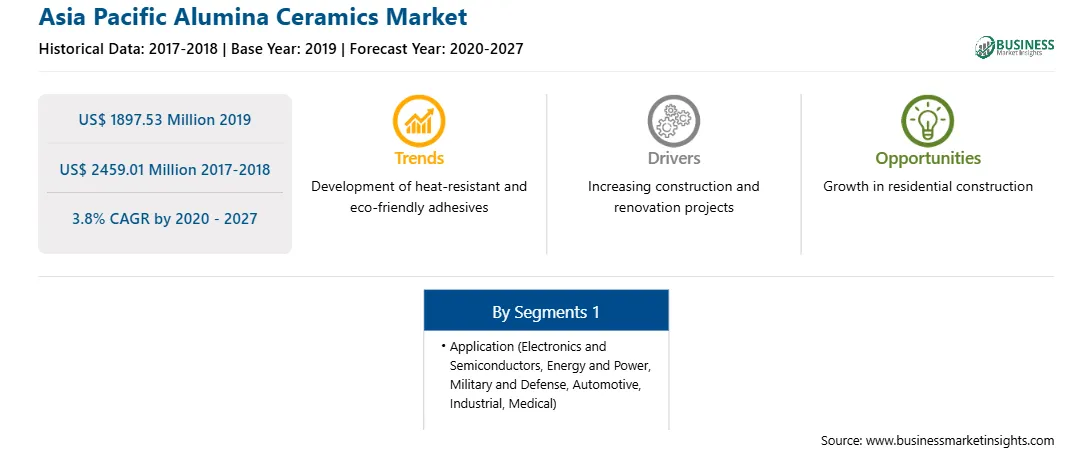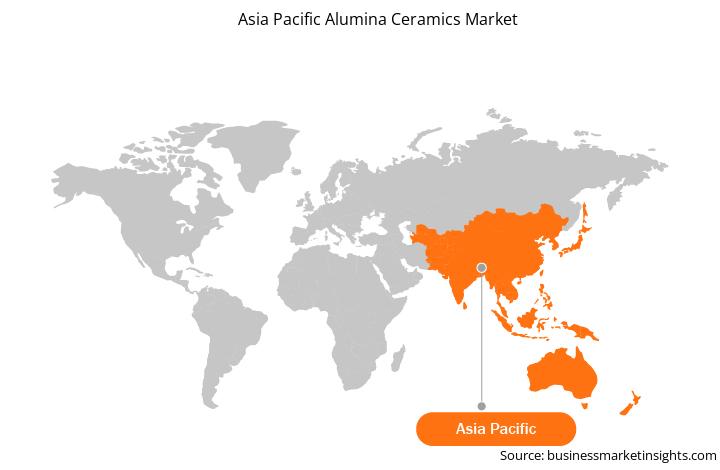Alumina ceramics is the most advanced engineering ceramics, providing outstanding electrical insulation properties, combined with high hardness and good wear resistance, but with relatively low strength and fracture strength. Alumina Ceramics are usually white but can also be pink (88 percent alumina) or brown (96 percent Alumina). High-purity alumina ceramics are ideal for environments where wear resistance and corrosive substances are necessary. Alumina ceramic has superior thermal stability, which means that it is commonly used in areas where high-temperature tolerance is important. Alumina ceramic is a material of choice for the alumina wear components. Proven wear and a heat resistance of alumina wear parts make them suitable for the manufacture of wear-resistant components.
Strategic insights for the Asia Pacific Alumina Ceramics provides data-driven analysis of the industry landscape, including current trends, key players, and regional nuances. These insights offer actionable recommendations, enabling readers to differentiate themselves from competitors by identifying untapped segments or developing unique value propositions. Leveraging data analytics, these insights help industry players anticipate the market shifts, whether investors, manufacturers, or other stakeholders. A future-oriented perspective is essential, helping stakeholders anticipate market shifts and position themselves for long-term success in this dynamic region. Ultimately, effective strategic insights empower readers to make informed decisions that drive profitability and achieve their business objectives within the market.

| Report Attribute | Details |
|---|---|
| Market size in 2019 | US$ 1897.53 Million |
| Market Size by 2027 | US$ 2459.01 Million |
| CAGR (2020 - 2027) | 3.8% |
| Historical Data | 2017-2018 |
| Forecast period | 2020-2027 |
| Segments Covered |
By Application
|
| Regions and Countries Covered | Asia-Pacific
|
| Market leaders and key company profiles |
|
The geographic scope of the Asia Pacific Alumina Ceramics refers to the specific areas in which a business operates and competes. Understanding local distinctions, such as diverse consumer preferences (e.g., demand for specific plug types or battery backup durations), varying economic conditions, and regulatory environments, is crucial for tailoring strategies to specific markets. Businesses can expand their reach by identifying underserved areas or adapting their offerings to meet local demands. A clear market focus allows for more effective resource allocation, targeted marketing campaigns, and better positioning against local competitors, ultimately driving growth in those targeted areas.

The alumina ceramic market in Asia- Pacific was valued at US$ 1897.53 million in 2019 and is projected to reach US$ 2459.01 million by 2027; it is expected to grow at a CAGR of 3.8% from 2020 to 2027. Growing focus on developing the manufacturing sector in the region, coupled with the benefits of inculcating advanced ceramics in industries such as aerospace and automotive, is expected to increase the market growth. The performance of these ceramics is driving global companies to integrate advanced ceramics into their products. All these factors are fuelling the market growth for electroplating in Asia- Pacific .
However, a higher cost of alumina ceramic as compared to metal and other alloys counterparts is expected to hinder the market growth in the Asia- Pacific . Besides, COVID-19 has affected economies and industries in various countries due to travel bans, lockdowns, and business shutdowns. The COVID-19 is anticipated to cause a loss of more than 3 Billion in the Asia Pacific region. The consequence and impact can be even worse and totally depends on the spread of the virus. The government of Asia Pacific is taking possible steps to reduce its effects by announcing lockdown, and thus, impact the revenue generated by the market. The Government have asked the chemicals & materials manufacturers to delay their production which will adversely affect the worldwide supply of alumina ceramics.
Based on application, the alumina ceramics market is categorized into electronics and semiconductors, energy and power, military and defence, automotive, industrial, medical, and others. In 2019, the electronics and semiconductors segment is dominating the Asia- Pacific Alumina Ceramic Market. Alumina ceramic is one of the most widely used advanced ceramic materials and is also an excellent electrical insulator. Alumina ceramic provides a blend of mechanical and electrical characteristics due to which it can be used for a wide range of applications.
A few major primary and secondary sources referred to for preparing this report on the Alumina Ceramics market in Asia- Pacific are company websites, annual reports, financial reports, national government documents, and statistical database, among others. Major companies listed in the report are BMW Steels Ltd., Ceramtec, Ferrotec Holdings Corporation , Kyocera Corporation, Morgan Advanced Materials, Saint Gobain S.A., Xiamen Innovacera Advanced Materials Co., Ltd among others.
Asia- Pacific Alumina Ceramics Market, by Application
Asia- Pacific Alumina Ceramics Market, by Country
The Asia Pacific Alumina Ceramics Market is valued at US$ 1897.53 Million in 2019, it is projected to reach US$ 2459.01 Million by 2027.
As per our report Asia Pacific Alumina Ceramics Market, the market size is valued at US$ 1897.53 Million in 2019, projecting it to reach US$ 2459.01 Million by 2027. This translates to a CAGR of approximately 3.8% during the forecast period.
The Asia Pacific Alumina Ceramics Market report typically cover these key segments-
The historic period, base year, and forecast period can vary slightly depending on the specific market research report. However, for the Asia Pacific Alumina Ceramics Market report:
The Asia Pacific Alumina Ceramics Market is populated by several key players, each contributing to its growth and innovation. Some of the major players include:
The Asia Pacific Alumina Ceramics Market report is valuable for diverse stakeholders, including:
Essentially, anyone involved in or considering involvement in the Asia Pacific Alumina Ceramics Market value chain can benefit from the information contained in a comprehensive market report.